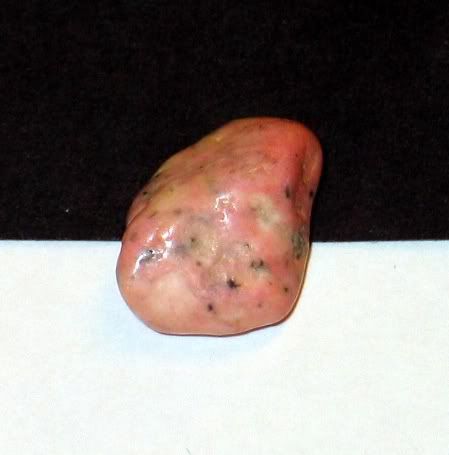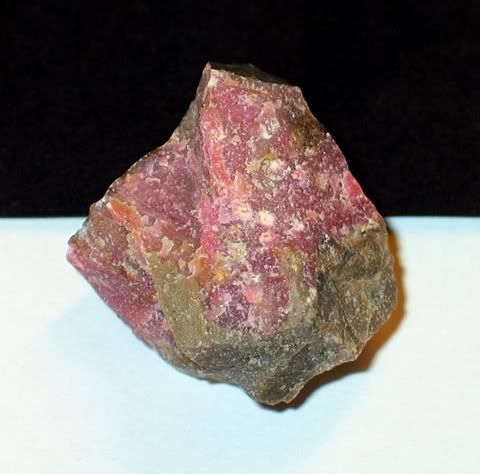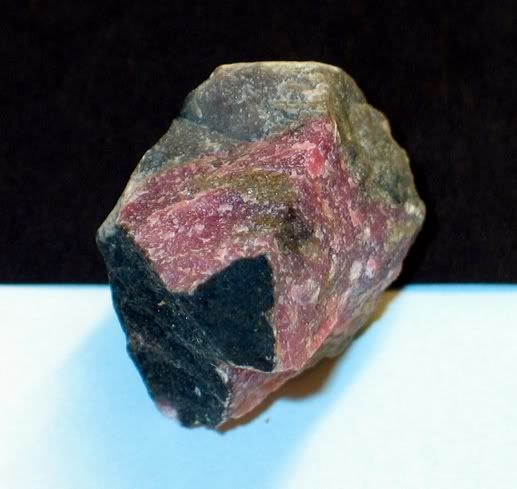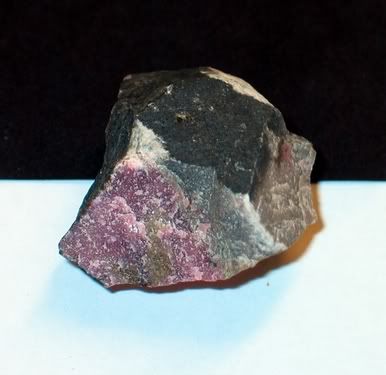Post by LCARS on Jan 25, 2006 2:33:27 GMT -5
I collected this relatively small piece of rhodonite (aprox 1cm long) on a local beach.

It is a pretty rare find as most of the rhodonite comes from the inland source up on Hill 60 in Cowichan Lake.
Almost all of the rhodonite found on beaches here has come from the Saltspring Island (or "Patricia") deposit and is often only found on beaches lining the East & Northern sides of the Saanich Peninsula.
Sidney Spit is an offshore sand bar beach island near the northeast end of the Saanich Peninsula. It faces the southern exposure of Saltspring Island where the rhodonite deposit showing at the Patricia site is thought to emerge under the sea and the island also lies in a tidal flux zone. (thus the long sandbars)
For this reason, "the spit" is a frequented stretch of real estate by local rock hounds in the know. Unfortunately, I have yet to venture out to the island to prospect...
Rhodonite is a relatively soft stone (aprox Mho's 6-6.5) and when tumbled with quartz or harder stones, it will wear faster in comparison. The stone in the photo above was only tumbled in an alox pre-polish then a cerium oxide polish since I was scared to let it shrink anymore in a silicon carbide grit.
The next three photos show some different pieces of rough rhodonite that I paid (too much) for at 75c/ounce!
These are all from the Hill 60 site in Lake Cowichan.



Rhodonite weathers black on the surface as it desilicates and a resulting manganese oxide layer forms, but one well executed strike with the pointy end of a rock hammer will reveal the beautiful crystal below the surface, ranging in color from tan, to brownish red and light salmon pink to fuscia to a deep purply pink. Manganese silicate is the primary constituent of rhodonite and largely determines the coloring. Black crystals, layers or patches infiltrating the matrix are quite common and often desired.
Rhodonite is traditionally known as a stone of love. Some technical details and other fine example photos of rhodonite can be found here:
www.gc.maricopa.edu/earthsci/imagearchive/rhodonite.htm
and here:
mineral.galleries.com/minerals/silicate/rhodonit/rhodonit.htm
and here:
www.webmineral.com/data/Rhodonite.shtml

It is a pretty rare find as most of the rhodonite comes from the inland source up on Hill 60 in Cowichan Lake.
Almost all of the rhodonite found on beaches here has come from the Saltspring Island (or "Patricia") deposit and is often only found on beaches lining the East & Northern sides of the Saanich Peninsula.
Sidney Spit is an offshore sand bar beach island near the northeast end of the Saanich Peninsula. It faces the southern exposure of Saltspring Island where the rhodonite deposit showing at the Patricia site is thought to emerge under the sea and the island also lies in a tidal flux zone. (thus the long sandbars)
For this reason, "the spit" is a frequented stretch of real estate by local rock hounds in the know. Unfortunately, I have yet to venture out to the island to prospect...
Rhodonite is a relatively soft stone (aprox Mho's 6-6.5) and when tumbled with quartz or harder stones, it will wear faster in comparison. The stone in the photo above was only tumbled in an alox pre-polish then a cerium oxide polish since I was scared to let it shrink anymore in a silicon carbide grit.
The next three photos show some different pieces of rough rhodonite that I paid (too much) for at 75c/ounce!
These are all from the Hill 60 site in Lake Cowichan.



Rhodonite weathers black on the surface as it desilicates and a resulting manganese oxide layer forms, but one well executed strike with the pointy end of a rock hammer will reveal the beautiful crystal below the surface, ranging in color from tan, to brownish red and light salmon pink to fuscia to a deep purply pink. Manganese silicate is the primary constituent of rhodonite and largely determines the coloring. Black crystals, layers or patches infiltrating the matrix are quite common and often desired.
Rhodonite is traditionally known as a stone of love. Some technical details and other fine example photos of rhodonite can be found here:
www.gc.maricopa.edu/earthsci/imagearchive/rhodonite.htm
and here:
mineral.galleries.com/minerals/silicate/rhodonit/rhodonit.htm
and here:
www.webmineral.com/data/Rhodonite.shtml









